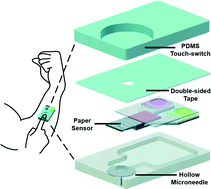One-touch-activated blood multidiagnostic system using a minimally invasive hollow microneedle integrated with a paper-based sensor†
Abstract
The development of real-time innocuous blood diagnosis has been a long-standing goal in healthcare; an improved, miniature, all-in-one point-of-care testing (POCT) system with low cost and simplified operation is highly desired. Here, we present a one-touch-activated blood multidiagnostic system (OBMS) involving the synergistic integration of a hollow microneedle and paper-based sensor, providing a number of unique characteristics for simplifying the design of microsystems and enhancing user performance. In this OBMS, all functions of blood collection, serum separation, and detection were sequentially automated in one single device that only required one-touch activation by finger-power without additional operations. For the first time, we successfully demonstrated the operation of this system in vivo in glucose and cholesterol diagnosis, showing a great possibility for human clinical application and commercialization. Additionally, this novel system offers a new approach for the use of microneedles and paper sensors as promising intelligent elements in future real-time healthcare monitoring devices.


 Please wait while we load your content...
Please wait while we load your content...